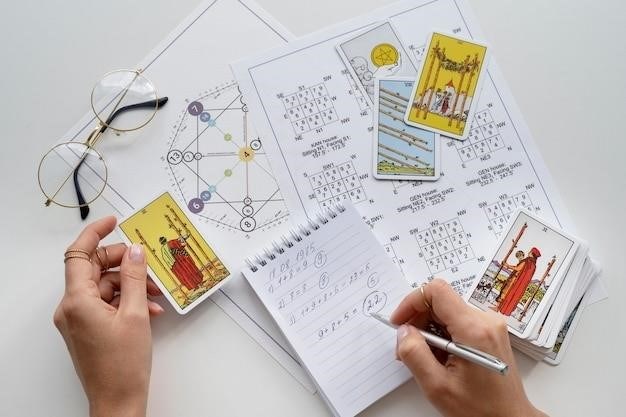Rider-Waite Tarot Guidebook PDFs⁚ A Comprehensive Guide
This guide explores the Rider-Waite Tarot, a popular deck․ Discover its history, structure, and interpretation․ Learn about its key figures, card meanings, and effective spread techniques․ Find resources for reliable PDFs and ethical usage․
Introduction to the Rider-Waite Tarot
The Rider-Waite-Smith Tarot, often shortened to Rider-Waite, is arguably the most popular and widely used Tarot deck globally․ Its enduring appeal stems from its clear and evocative imagery, making it accessible to both beginners and experienced readers․ Unlike some decks with abstract or symbolic representations, the Rider-Waite features richly detailed illustrations that readily lend themselves to intuitive interpretation․ Pamela Colman Smith’s artistic vision, under the guidance of Arthur Edward Waite, created a deck that resonates with a broad audience․ This accessibility has made it the foundation for countless Tarot books, guides, and online resources, solidifying its status as a cornerstone of modern Tarot practice․ The deck’s structure, comprising 78 cards divided into the Major and Minor Arcana, provides a rich framework for exploring themes of life, spirituality, and personal growth․ Many find the Rider-Waite a perfect starting point for their Tarot journey․
History and Origins of the Rider-Waite Deck
The Rider-Waite Tarot’s origins trace back to the early 20th century, a period of burgeoning interest in the occult and esoteric traditions․ Commissioned by Arthur Edward Waite, a prominent occultist and scholar of esoteric knowledge, the deck’s artwork was masterfully rendered by Pamela Colman Smith, a talented artist with a deep understanding of symbolism․ Waite, known for his extensive writings on the Kabbalah and Tarot, sought to create a deck that was both accessible and faithful to the traditional structure of the Tarot․ While not the first Tarot deck, the Rider-Waite’s innovative design, featuring richly detailed imagery that clearly represents the card’s meaning, set it apart․ Published by Rider & Company in 1909, it was initially met with mixed reception but gradually gained popularity, eventually becoming a standard in the Tarot world․ Its widespread adoption is partly due to its clear and readily interpretable symbolism, making it a user-friendly introduction to Tarot for many․
Key Figures⁚ Arthur Waite and Pamela Colman Smith
Arthur Edward Waite, a prominent occultist and ceremonial magician, played a pivotal role in the creation of the Rider-Waite Tarot․ His deep understanding of esoteric traditions, including the Kabbalah and Hermeticism, heavily influenced the deck’s symbolic structure and philosophical underpinnings․ Waite’s involvement ensured the Rider-Waite’s alignment with established occult principles while striving for accessibility․ Pamela Colman Smith, the artist responsible for the deck’s iconic imagery, brought Waite’s vision to life․ A multi-talented individual, Smith was an illustrator, writer, and actress, and her artistic skills were essential in creating the evocative and symbolic representations found on each card․ The collaboration between Waite’s esoteric knowledge and Smith’s artistic genius resulted in a deck that is both insightful and visually captivating, making it a cornerstone of modern Tarot practice․ Their combined efforts established a deck that continues to inspire and guide Tarot practitioners worldwide․
The Structure of the Rider-Waite Tarot⁚ Major and Minor Arcana
The Rider-Waite Tarot, like most Tarot decks, is structured around two main sections⁚ the Major and Minor Arcana․ The Major Arcana comprises 22 cards, each representing a significant archetype or life lesson, often depicted through allegorical figures and symbolic imagery․ These cards usually represent major life events, karmic lessons, or significant spiritual shifts․ They are numbered, typically from 0 (The Fool) to 21 (The World), although the numbering may vary slightly depending on the deck․ The Minor Arcana consists of 56 cards, divided into four suits⁚ Wands (representing fire, action, and energy), Cups (representing water, emotions, and relationships), Swords (representing air, intellect, and conflict), and Pentacles (representing earth, material matters, and finances)․ Each suit contains numbered cards (Ace through Ten) and four Court Cards (Page, Knight, Queen, and King), each embodying specific personality traits and archetypes within their respective suit․ Understanding the structure provides a framework for interpreting the cards’ meanings and their interconnectedness within a reading․

Understanding the Major Arcana Cards
The 22 Major Arcana cards in the Rider-Waite Tarot represent significant life journeys and archetypal energies․ Each card holds profound symbolic meaning, often depicting allegorical figures and scenes rich in symbolism․ Interpretations can vary, but common themes emerge․ The Fool, for instance, signifies new beginnings and taking leaps of faith, while The World represents completion and fulfillment․ Cards like The Magician symbolize manifestation and power, whereas The Empress embodies nurturing and abundance․ The Hierophant represents tradition and established structures, while The Tower signifies sudden upheaval and unexpected change․ Death is not literal but signifies transformation and endings that pave the way for new beginnings․ The Devil represents temptation and karmic patterns, and The Star offers hope and renewal․ Understanding these archetypes and their associated symbolism is crucial for accurate interpretations within a reading․
Interpreting the Minor Arcana Suits⁚ Cups, Wands, Swords, Pentacles
The Minor Arcana’s 56 cards are divided into four suits, each representing a different aspect of life․ Cups symbolize emotions, relationships, and the inner world․ Wands represent creativity, passion, and willpower․ Swords signify intellect, conflict, and challenges․ Pentacles represent the material world, finances, and practicality․ Each suit has numbered cards (Ace through Ten) and court cards (Page, Knight, Queen, King), each adding nuance to the suit’s overall meaning․ The numbered cards often represent stages of development within the suit’s theme․ For example, the Cups suit’s progression might show a gradual increase in emotional maturity, starting with the Ace’s overflowing potential and culminating in the Ten’s emotional saturation․ Court cards often embody specific character traits or roles relevant to the suit․ Careful consideration of both number and court card adds depth to interpretations of Minor Arcana cards․
Utilizing Tarot Spreads for Readings
Tarot spreads are configurations of cards used to gain insight into a question or situation․ The simplest spread is a single-card draw, offering a direct answer․ More complex spreads, like the three-card past-present-future spread, provide a broader perspective․ The Celtic Cross is a ten-card spread offering a detailed analysis, examining various influences․ Choosing a spread depends on the complexity of the question and the level of detail desired․ Each position in a spread holds specific meaning; for example, in a three-card spread, the first card may represent the past, the second the present, and the third the future or potential outcome․ Before choosing a spread, it’s important to clearly formulate your question․ The clarity of your question directly impacts the clarity of the reading․ Remember, the cards are tools for self-reflection; the ultimate interpretation lies within your own intuition and understanding;

Finding and Downloading Reliable Rider-Waite Tarot PDFs
Locating trustworthy Rider-Waite Tarot PDFs requires careful consideration․ Avoid sites offering free downloads of copyrighted material; this often infringes on intellectual property rights․ Reputable sources for learning about the Rider-Waite Tarot include established publishers’ websites offering digital versions of their books, or educational platforms specializing in esoteric subjects․ These often provide excerpts or introductory materials for free, allowing you to sample their content before purchase․ Public libraries may also offer digital access to books about the Rider-Waite Tarot through their online resources․ If you find a PDF online, check for reviews and user comments to gauge its reliability․ Remember, high-quality images and accurate card interpretations are essential for a meaningful reading experience․ Prioritize reputable sources to ensure authenticity and avoid potential errors in card depictions or meanings․
Common Misconceptions about Rider-Waite Tarot PDFs
A prevalent misconception is that all online Rider-Waite Tarot PDFs are unreliable․ While many freely available PDFs may lack accuracy or clarity, high-quality digital versions exist from legitimate publishers․ Another misconception involves assuming that free PDFs are always ethically sourced․ Copyright infringement is a serious issue, and illegally downloaded materials can be of poor quality and may contain inaccuracies․ Some believe that only physical decks hold true spiritual power; however, the essence of Tarot lies in understanding the symbolism and imagery, regardless of the format․ Finally, some think that a PDF is a substitute for a genuine learning experience․ While PDFs can supplement learning, they should ideally complement, not replace, thorough study from reputable books and experienced practitioners․ Careful discernment and responsible sourcing are key to avoiding these common misunderstandings․
Legal and Ethical Considerations of Using Downloaded PDFs
Downloading copyrighted Rider-Waite Tarot guidebook PDFs without permission is illegal․ Publishers hold intellectual property rights, and unauthorized distribution infringes upon these rights․ Respecting copyright protects creators and ensures the availability of high-quality resources․ Ethically, using illegally obtained PDFs undermines the creators’ livelihood and discourages further development of accurate and insightful materials․ Consider the creators’ efforts and the value of their work․ Supporting legitimate publishers ensures that accurate and well-researched materials are readily available for others․ If you’re on a budget, explore options such as borrowing from libraries or seeking out public domain materials․ Remember, responsible use fosters a sustainable environment for creators and learners alike․ Respecting copyright is essential for the continued growth and development within the Tarot community․
Resources for Further Learning and Practice
Numerous resources exist for deepening your understanding and practical application of the Rider-Waite Tarot․ Websites like Biddy Tarot offer comprehensive online guides, tutorials, and interpretations․ Books such as “The Ultimate Guide to the Rider-Waite Tarot” by Johannes Fiebig and Evelin Burger provide in-depth analyses․ YouTube channels dedicated to Tarot offer visual learning experiences․ Consider joining online forums or communities for discussions and sharing interpretations; Participating in workshops or classes provides hands-on experience and interaction with experienced readers․ Practicing regularly with different spreads is crucial for developing intuition and refining your skills․ Remember, consistent practice and engagement with various learning platforms are key to mastering the Rider-Waite Tarot and enhancing your intuitive abilities․ Explore diverse resources to find a learning style that suits you best․ Continuous learning is fundamental to a fulfilling Tarot journey․





